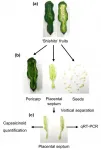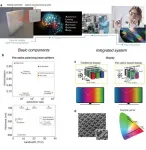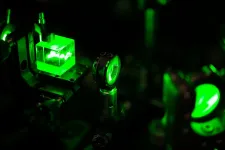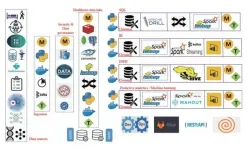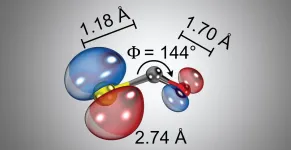World's first dinosaur preserved sitting on nest of eggs with fossilized babies
2021-03-09
(Press-News.org) The fossil in question is that of an oviraptorosaur, a group of bird-like theropod dinosaurs that thrived during the Cretaceous Period, the third and final time period of the Mesozoic Era (commonly known as the 'Age of Dinosaurs') that extended from 145 to 66 million years ago. The new specimen was recovered from uppermost Cretaceous-aged rocks, some 70 million years old, in Ganzhou City in southern China's Jiangxi Province.
"Dinosaurs preserved on their nests are rare, and so are fossil embryos. This is the first time a non-avian dinosaur has been found, sitting on a nest of eggs that preserve embryos, in a single spectacular specimen," explains Dr. Shundong Bi.
The fossil consists of an incomplete skeleton of a large, presumably adult oviraptorid crouched in a bird-like brooding posture over a clutch of at least 24 eggs. At least seven of these eggs preserve bones or partial skeletons of unhatched oviraptorid embryos inside. The late stage of development of the embryos and the close proximity of the adult to the eggs strongly suggests that the latter died in the act of incubating its nest, like its modern bird cousins, rather than laying its eggs or simply guarding its nest crocodile-style, as has sometimes been proposed for the few other oviraptorid skeletons that have been found atop nests.
"This kind of discovery, in essence fossilized behavior, is the rarest of the rare in dinosaurs," explains Dr. Lamanna. "Though a few adult oviraptorids have been found on nests of their eggs before, no embryos have ever been found inside those eggs. In the new specimen, the babies were almost ready to hatch, which tells us beyond a doubt that this oviraptorid had tended its nest for quite a long time. This dinosaur was a caring parent that ultimately gave its life while nurturing its young."
The team also conducted oxygen isotope analyses that indicate that the eggs were incubated at high, bird-like temperatures, adding further support to the hypothesis that the adult perished in the act of brooding its nest. Moreover, although all embryos were well-developed, some appear to have been more mature than others, which in turn suggests that oviraptorid eggs in the same clutch might have hatched at slightly different times. This characteristic, known as asynchronous hatching, appears to have evolved independently in oviraptorids and some modern birds.
One other interesting aspect of the new oviraptorid specimen is that the adult preserves a cluster of pebbles in its abdominal region. These are almost certainly gastroliths, or "stomach stones," rocks that would have been deliberately swallowed to aid the dinosaur in digesting its food. This is the first time that undoubted gastroliths have been found in an oviraptorid, and as such, these stones may provide new insights into the diets of these animals.
Says Dr. Xu, "It's extraordinary to think how much biological information is captured in just this single fossil. We're going to be learning from this specimen for many years to come."
INFORMATION:
See the article:
Bi, S., Amiot, R., de Fabrègues, C.P., Pittman, M., Lamanna, M.C., Yu, Y., Yu, C., Yang, T., Zhang, S., Zhao, Q. and Xu, X., 2020. An oviraptorid preserved atop an embryo-bearing egg clutch sheds light on the reproductive biology of non-avialan theropod dinosaurs. Science Bulletin. 2020, https://doi.org/10.1016/j.scib.2020.12.018.
[Attachments] See images for this press release:
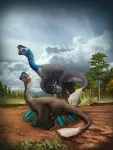
ELSE PRESS RELEASES FROM THIS DATE:
2021-03-09
For the first time, two researchers--one from the University of Copenhagen and the other from Columbia University--have accurately dated the arrival of the first herbivorous dinosaurs in East Greenland. Their results demonstrate that it took the dinosaurs 15 million years to migrate from the southern hemisphere, as a consequence of being slowed down by extreme climatic conditions. Their long walk was only possible because as CO2 levels dropped suddenly, the Earth's climate became less extreme.
A snail could have crawled its way faster. 10,000 km over 15 million years--that's how long it took the first herbivorous dinosaurs to make their way from Brazil and Argentina all the way to East Greenland. This, according to a new study by Professor ...
2021-03-09
Chili peppers (Capsicum spp.) are an important spice and vegetable that supports food culture around the world, whose intensity of its pungent taste is determined by the content of capsicumoids. However, the content of capsicumoids varies depending on the variety and is known to fluctuate greatly depending on the cultivation environment. This can be a big problem in the production, processing and distribution of peppers where sweet varieties can be spicy and highly spicy varieties are just only mildly spicy. It is thought that changes in the expression of multiple genes involved in capsaicinoid biosynthesis are involved in such changes in pungent taste ...
2021-03-09
When something bad happens to a child, the public and policy response is swift and forceful.
How could this have happened?
What went wrong?
What do we do to make sure it never happens again?
When a family becomes erroneously or unnecessarily enmeshed in the child welfare system, that burden is largely invisible - a burden borne mostly by the family itself.
In both situations, the fault for the systemic failure is often placed on the caseworker - overburdened, under-resourced, and forced to make quick and critical judgments about the risk ...
2021-03-09
In a new paper published in Light Science & Application, the group led by Professor Andrea Fratalocchi from Primalight Laboratory of the Computer, Electrical and Mathematical Sciences and Engineering (CEMSE) Division, King Abdullah University of Science and Technology (KAUST), Saudi Arabia, introduced a new patented, scalable flat-optics technology manufactured with inexpensive semiconductors.
The KAUST-designed technology leverages on a previously unrecognized aspect of optical nanoresonators, which are demonstrated to possess a physical layer that is completely equivalent to a feed-forward deep neural network.
"What we have achieved," explains Fratalocchi, "is a ...
2021-03-09
Obtaining a precise understanding of magnetic structures is one of the main objectives of solid-state physics. Significant research is currently being undertaken in this field, the aim being to develop future data processing applications that use tiny magnetic structures as information carriers. Physicists at Johannes Gutenberg University Mainz (JGU) and the Helmholtz Institute Mainz (HIM) recently presented a new method for investigating magnetic structures combining two different techniques. This allows to measure and map the magnetization as well as the magnetic ...
2021-03-09
For ice, so-called "surface melting" was postulated as early as the 19th century by Michael Faraday: Already below the actual melting point, i.e. 0 °C, a thin liquid film forms on the free surface because oft he interface between ice and air. Scientists led by Markus Mezger, group leader at the Max Planck Institute for Polymer Research (department of Hans-Jürgen Butt) and professor at the University of Vienna, have now studied this phenomenon in more detail at interfaces between ice and clay minerals.
In nature, this effect is particularly interesting in permafrost soils - i.e. soils that are permanently frozen. About a quarter of the land area ...
2021-03-09
The efficient provision of medical care is integral to society. Over time, the healthcare industry has tapped into modern technology in order to keep up its quality of service. This has, unsurprisingly, led to huge volumes of patient data. But it's not just patients whose data need to be stored; doctors, physicians, clinical staff, and even smart wearable gadgets are contributing to what is coming to be known as "healthcare big data."
Big data analytics (BDA), which involves the use of special design architectures to manage, store, and analyze complex data, is an important tool in healthcare. But it is hard to implement, owing to its high failure rate, resource-intensive process, and--most importantly--a lack of a clear guideline to aid practitioners. ...
2021-03-09
Light microscopes have revolutionized our understanding of the microcosmos, but their resolution is limited to about 100 nanometers. To see how molecules bond, break, or change their structure, we need at least 1000 times better resolution.
Laser induced electron diffraction (LIED) is a technique which allows to pinpoint the individual atoms inside a single molecule, and to see where each atom moves when the molecule undergoes a reaction. This technique proved to be an amazing tool for the imaging molecules, such as water, carbonyl sulfide or carbon disulfide. However, using a strong laser field to generate the electron diffraction presented challenges in retrieving the exact structure, since the structural resolution depended on exact knowledge of the ...
2021-03-09
New Haven, Conn. -- Mailing a package of SARS-CoV-2 tests to every household in America and asking people to use them once a week could greatly reduce total infections and mortality at a justifiable cost, a new study led by the Yale School of Public Health finds.
The research, published today in Annals of Internal Medicine, considers rapid antigen tests that warn people, in real-time, that they are potentially contagious and that they should isolate themselves before unknowingly spreading the disease to others. Investigators, led by Professor A. David Paltiel, assembled data on the epidemiology of SARS-CoV-2 and the natural history of COVID-19. They then used a mathematical model to estimate how many infections, hospitalizations, and deaths could be averted - and at what cost - by providing ...
2021-03-09
As much as a year's worth of past academic progress made by disadvantaged children in the Global South may have been wiped out by school closures during the COVID-19 pandemic, researchers have calculated.
The research, by academics from the University of Cambridge and RTI International, attempts to quantify the scale of learning loss that children from poor and marginalised communities in the Global South may have experienced, and the extent to which home support and access to learning resources could ameliorate it. While it is known that the education of these children has suffered disproportionately during the pandemic, it is much harder to measure exactly how much their academic progress has ...
LAST 30 PRESS RELEASES:
[Press-News.org] World's first dinosaur preserved sitting on nest of eggs with fossilized babies

